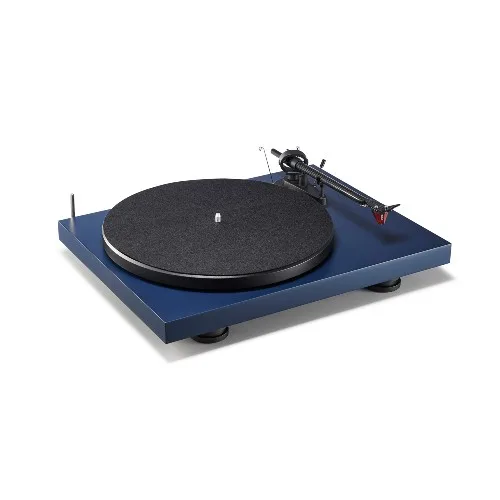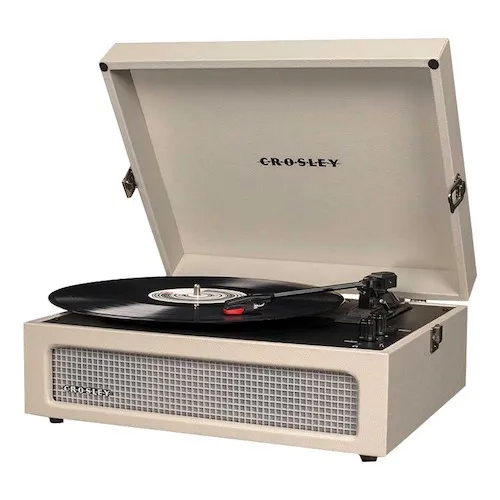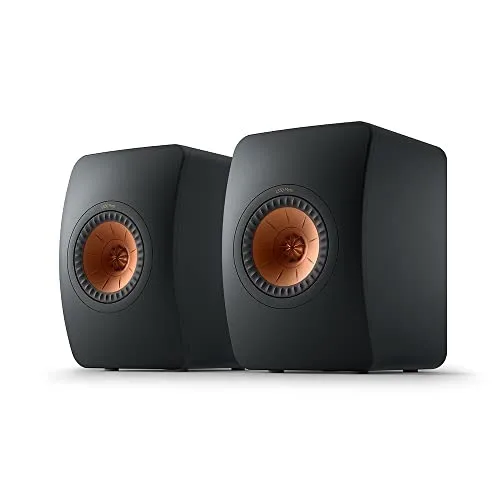Top Pick for
Overall turntable

Top Pick for
Overall turntable

Top Pick for
Budget turntable

Top Pick for
Turntable for audiophiles

Top Pick for
Speakers for turntables

Turntables, also known as record players, have seen a recent resurgence in popularity. This is likely due to the vinyl revival and the fact that many believe that the sound quality of records is superior to that of digital formats. If you're interested in picking up a turntable, there are a few things you need to keep in mind.
The first thing to consider is what type of turntable you want. There are 2 main types: manual and automatic. Manual turntables require you to lift the tonearm and place the record on the platter yourself. Automatic turntables do this for you. Which type you choose is essentially a matter of personal preference.
To make your decision easier, our team has compiled a list of the best turntables available online. We evaluated options from brands like Rega, Fluance, Yamaha, Audio-Technica and more. We examined turntables based on customer ratings and reviews and their key features.
Read more detail on our methodology below.

The Pro-Ject Debut Carbon EVO is our pick for the best overall turntable you can get online. On Amazon, it has a rating of 4.6 out of 5 stars from over 500 reviews.
This turntable features an 8.6" 1-piece carbon fibre tonearm with a Sumiko Rainier phono cartridge to give you the best audio-listening experience possible. It also has a 12" steel platter lined around the outer edge with an anti-resonant thermos-plastic elastomer for a heavier platter with minimal noise.
There are also vibration-absorbing feet to isolate the unit and a rotational mass for improved flywheel effect. This feature helps minimise wow and flutter while offering better stability for damping resonance.
Hundreds of buyers were impressed by the turntable's ease of use, performance and substantial build. It is quite pricey, but the unit is a pretty superb piece of equipment for both beginners and audiophiles alike. Some found the dust cover to be a little stiff to lift, but this seems to be a minor issue.

With a rating of 4.5 out of 5 stars on Amazon and Harvey Norman, we recommend the Crosley Voyager Portable Bluetooth Turntable as the best option if you're on a budget.
Featuring a vintage-inspired aesthetic, this portable turntable offers Bluetooth capability and a compact design that fits into any space. It can spin 33 1/3, 45 or 78 RPM records or you can use its Bluetooth receiver to listen to your digital music using the unit's stereo speakers. Moreover, this has RCA outputs, allowing you to easily plug it into your solar music system or speakers for a more immersive listening experience.
The Voyager is a great entry-level turntable if you're on a budget. Not only does it look good, but the set-up is pretty straightforward. You can listen to your favourite records right away – no need to buy separate speakers to get started. However, this convenience comes with a disadvantage. The built-in speakers aren't the best and this may be a deal breaker for audiophiles and seasoned vinyl listeners.
6% off Crosley Voyager Portable Bluetooth Turntable

If you're looking for a vintage model, check out Victrola's Vintage 3-Speed Bluetooth Suitcase Turntable with Speakers, which has a rating of 4.5 out of 5 stars on Amazon.
This Victrola turntable is equipped with Bluetooth capability and built-in speakers for a compact design. It offers 3 speed settings – 33 1/3, 45 and 78 RPM so you can play all your favourite albums without any issue. There is also a 3.5mm aux-in for playing music from your non-Bluetooth device.
The general sentiment is that this is a pretty solid turntable with a decent price point. At $229, customers said it's ideal for beginners or those who want a turntable that looks amazing while offering decent performance. The built-in speakers aren't the best, but you can always connect them with a separate system for improved results.

We chose the TEAC TN-180BT-A3 as the best Bluetooth turntable. It has a rating of 4.4 out of 5 stars on Amazon. This model is designed for audiophiles, featuring a belt-drive motor for clearer and richer sounds.
The TN-180BT-A3 has a single wood board cabinet with high-density MDF to reduce vibrations and provide clearer audio. You also get 3 speeds and an auto-return mechanism for convenience.
Apart from Bluetooth connectivity, this model offers a built-in MM amplifier with phono EQ. Additionally, you can also connect to your hi-fi system with or without phono output using the included RCA cable.
This turntable produces richer and warmer sounds compared to other Bluetooth options out there. Customers said it's a great model for audiophiles looking for a Bluetooth turntable. The build is pretty sturdy and the belt drive helps reduce vibration and noise for a cleaner sound. Set-up can be cumbersome, but this seems to be a non-issue for most users.

We recommend Audio-Technica's ATLP120XUSB for people looking for a USB-style turntable. On Amazon and eBay, this model has a rating of 4.7 out of 5 stars.
Featuring a DC servo motor, the ATLP120XUSB offers a fully manual operation and an adjustable dynamic anti-skate control. It has 33, 45 and 78 RPM speeds and an AT VM95E dual magnet phono cartridge with a 0.3 x 0.7mm elliptical stylus. The cartridge is also compatible with any VM95 series replacement stylus. It has a built-in switchable phono pre-amp as well.
Priced at $550, this is a great entry-level fully manual turntable. The player produces well-balanced sound quality with reduced noise and a clean treble. The bass tones are punchy, too. While some may be intimidated by the manual operation, the process is pretty straightforward to follow, even for beginners. When it comes to the build, this is made of ABS plastic but it feels and looks durable.

With an average rating of 4.85 out of 5 stars on Amazon and Harvey Norman, we recommend the Yamaha MusicCast Vinyl 500 Wireless Turntable as the best option under $1,000.
The Yamaha MusicCast Vinyl 500 Wireless Turntable is a modern turntable featuring Wi-Fi connectivity, letting you stream your favourite songs via the brand's MusicCast app. It also has Bluetooth connectivity and a static-balanced straight tonearm for sound transparency and openness.
For added convenience, it also supports voice control and allows you to listen to music from various streaming services. It has a DC motor and a 33 1/3 RPM and 45 RPM switch as well.
With heaps of premium features, there's no question why this model is a favourite among music enthusiasts. The added modern functions help improve the listening experience, offering better warmth and richness to any record. However, it is worth noting that this doesn't have a stop-and-return feature on the arm, which may be a con for some users.
16% off Yamaha MusicCast Vinyl 500 Wireless Turntable

For beginners, we picked the Audio Technica AT-LP60XBT-BK as the best option. This has a rating of 4.8 out of 5 stars on Amazon from more than 5,000 reviews.
Featuring high-fidelity audio with Bluetooth technology, this record player lets you connect the device to speakers and other audio systems. It is fully automatic with 2 speeds: 33 1/3 and 45 RPM. Additionally, it is compatible with the aptX codec and has a built-in phono pre-amplifier for crisp sounds. The turntable comes with a removable diamond stylus as well.
Customers gave positive feedback on the turntable's value for money, sound quality and durable build. It produces crisp sounds with classic vinyl crackles for a unique listening experience. Reviewers said that pairing the device via Bluetooth is a breeze, while others mentioned that using speakers further enhances the turntable's superb sound quality.
Some reviews said its included stylus is a bit rough sounding. It also doesn't come with a manual, which makes the set-up a bit confusing.
10% off Audio Technica AT-LP60XBT-WH

Fluance's RT85 is our pick for the best turntable for audiophiles. On Amazon, it has a rating of 4.8 out of 5 stars from over 400 customer reviews.
With a pure analog performance, this delivers a warm, uncompressed and immersive listening experience. It doesn't have any electronic signal path for a more transparent and crisper sound.
There is also an Oroton 2M Blue Cartridge to help reproduce more sound details while maintaining a flat frequency response. And the acrylic platter provides better inertia for consistent speed. The motor is pretty silent and doesn't produce much vibration.

The KEF LS50 Meta is what we recommend as the best speakers you can get for your turntable. This model has 4.8 out of 5 stars on Amazon.
The LS50 Meta is designed around the Uni-Q Generation with Metamaterial Absorption Technology for detailed sound anywhere in the room. It also features the brand's Driver Performance Optimisation for improved acoustic performance and an immersive sound.
With a sleek and compact design, this also blends into any space. The smooth curved surfaces look modern while also helping radiate sound across the baffle without any interference.
For this list, we looked into hundreds of turntables in various online retailers like Amazon, Appliances Online and Harvey Norman. We evaluated models from the following brands:
We narrowed down our choices based on customer ratings and reviews from the past year). We also considered each model's key product features, ease of use, platter design, drive, speed settings and value for money. For the best cheap category, we evaluated models under $500.
If you're buying a turntable, you'll need to pick up an amplifier and speakers separately. Some turntables have a built-in pre-amp, but some don't, so you may need to add one to your list. This can inflate the cost of your first vinyl player, so be sure to plan ahead. Try to get products in the same price range. An expensive set of speakers won't redeem a poorly constructed amp.
There are many reasons to go out and buy a turntable or record player. These include:
Record players and turntables can't offer everything. The drawbacks to these music players are:
Turntable prices start at around $70 and can reach over $1,000. When buying a turntable or record player, the cost is often reflective of sound quality. You'll also want to consider:
There are 3 main speed settings for vinyl players. 33 1/3 RPM is the most common playback speed for 12-inch vinyl – you need it on your turntable or record player. 45 RPM is the speed for 7-inch records – you need this too. 78 RPM is the speed for shellac records and is far more uncommon as not many 78 RPM records were ever produced. Be sure that the vinyl player you buy can play the records in your collection.
Damping is the process of reducing vibrations. Too much vibration in your turntable or record player can impact sound quality. There are many design tricks that can incorporate damping technology, including damped cueing (slowing the lowering of the tonearm). The number of feet on a record player also serves as a form of damping. The more feet on your machine, the more stable it will be and the less it will vibrate.
The cartridge that comes with your turntable or record player is going to be appropriate for that machine. Moving magnet (MM) cartridges are a step up from cheaper ceramic options and do a good job. If you've purchased a high-end vinyl player, you may want to invest in a moving coil (MC) cartridge, but these can be hard to find.
This references the way the stylus is placed on the record. Automatic systems will do it for you at the push of a button, whereas manual systems require you to do it yourself. Most high-end turntables and record players are actually manual. Placing the stylus on the record is not a hard thing to do.
The larger the platter, the more stable the base for your record. The material of your platter tends to be a matter of preference, but sturdier materials age more gracefully. Platter mats can help with damping and ensure that the undersides of your records don't get scratched. Some machines have these built-in, while some offer them as purchasable accessories. They are generally worthwhile.
There are 2 types of drive: direct and belt. The type of drive you select is a matter of preference. Direct drives provide greater accuracy of speed, while belt drives are said to cause less sound interference.
Some machines are Bluetooth compatible or have auxiliary inputs that allow you to connect other devices.



These are the 8 best dash cams available online, from the best 4K option to the top model for motorcycles.
We compared product features and read real customer reviews to find the best alarm clocks you can buy right now.
We did the research, now here are the 6 best tripods available in Australia.
These are the 7 best cordless phones you can buy in Australia right now.
We read hundreds of reviews to find the best computer speakers in Australia.
This is the best antivirus software available in Australia right now, no matter what device you need to protect.
These are the 10 best laptop stands you can get right now in Australia.
LG's gadgets this year will all feature LG's ThinQ AI for everything from driving controls to TV selections.
Optometrists are seeing rising levels of device-related damage.